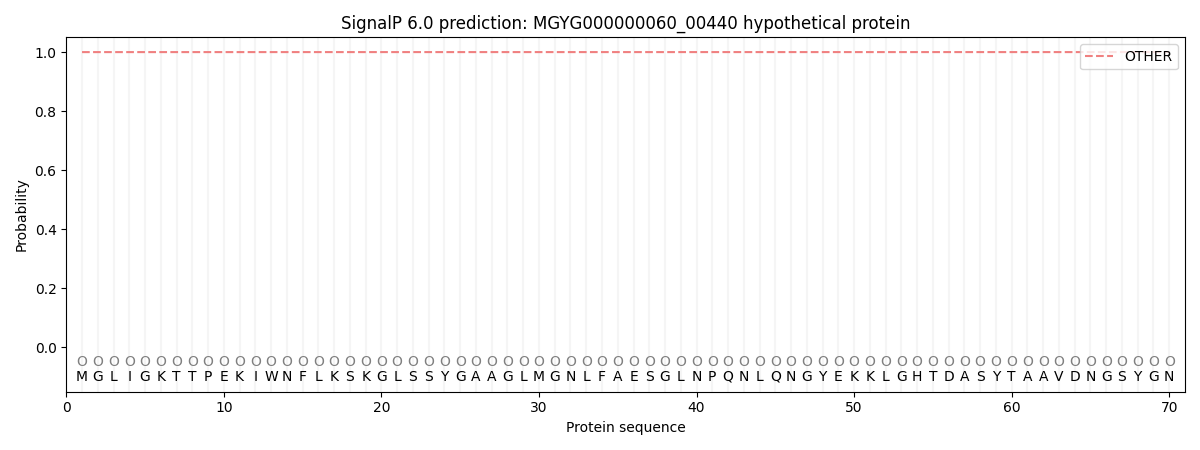You are browsing environment: HUMAN GUT
CAZyme Information: MGYG000000060_00440
You are here: Home > Sequence: MGYG000000060_00440
Basic Information |
Genomic context |
Full Sequence |
Enzyme annotations |
CAZy signature domains |
CDD domains |
CAZyme hits |
PDB hits |
Swiss-Prot hits |
SignalP and Lipop annotations |
TMHMM annotations
Basic Information help
| Species | Lachnospira eligens_A | |||||||||||
|---|---|---|---|---|---|---|---|---|---|---|---|---|
| Lineage | Bacteria; Firmicutes_A; Clostridia; Lachnospirales; Lachnospiraceae; Lachnospira; Lachnospira eligens_A | |||||||||||
| CAZyme ID | MGYG000000060_00440 | |||||||||||
| CAZy Family | CBM50 | |||||||||||
| CAZyme Description | hypothetical protein | |||||||||||
| CAZyme Property |
|
|||||||||||
| Genome Property |
|
|||||||||||
| Gene Location | Start: 454581; End: 455993 Strand: - | |||||||||||
CDD Domains download full data without filtering help
| Cdd ID | Domain | E-Value | qStart | qEnd | sStart | sEnd | Domain Description |
|---|---|---|---|---|---|---|---|
| pfam18013 | Phage_lysozyme2 | 3.31e-35 | 10 | 170 | 4 | 139 | Phage tail lysozyme. This domain has a lysozyme like fold. It is found in the tail protein of various phages probably giving them the ability to degrade the host cell wall peptidoglycan layer. |
| pfam01476 | LysM | 1.42e-16 | 374 | 417 | 1 | 43 | LysM domain. The LysM (lysin motif) domain is about 40 residues long. It is found in a variety of enzymes involved in bacterial cell wall degradation. This domain may have a general peptidoglycan binding function. The structure of this domain is known. |
| cd00118 | LysM | 6.24e-16 | 373 | 416 | 2 | 45 | Lysin Motif is a small domain involved in binding peptidoglycan. LysM, a small globular domain with approximately 40 amino acids, is a widespread protein module involved in binding peptidoglycan in bacteria and chitin in eukaryotes. The domain was originally identified in enzymes that degrade bacterial cell walls, but proteins involved in many other biological functions also contain this domain. It has been reported that the LysM domain functions as a signal for specific plant-bacteria recognition in bacterial pathogenesis. Many of these enzymes are modular and are composed of catalytic units linked to one or several repeats of LysM domains. LysM domains are found in bacteria and eukaryotes. |
| PRK06347 | PRK06347 | 6.93e-16 | 350 | 468 | 460 | 591 | 1,4-beta-N-acetylmuramoylhydrolase. |
| smart00257 | LysM | 1.77e-15 | 374 | 416 | 2 | 44 | Lysin motif. |
CAZyme Hits help
| Hit ID | E-Value | Query Start | Query End | Hit Start | Hit End |
|---|---|---|---|---|---|
| QJU19025.1 | 1.02e-115 | 171 | 469 | 200 | 497 |
| QQR02580.1 | 2.64e-84 | 96 | 469 | 118 | 563 |
| QUO22979.1 | 1.02e-81 | 1 | 469 | 1 | 504 |
| AFB75734.1 | 3.99e-81 | 1 | 469 | 1 | 504 |
| CBK91936.1 | 1.35e-68 | 186 | 417 | 1 | 304 |
Swiss-Prot Hits download full data without filtering help
| Hit ID | E-Value | Query Start | Query End | Hit Start | Hit End | Description |
|---|---|---|---|---|---|---|
| Q49UX4 | 8.51e-12 | 374 | 468 | 88 | 193 | N-acetylmuramoyl-L-alanine amidase sle1 OS=Staphylococcus saprophyticus subsp. saprophyticus (strain ATCC 15305 / DSM 20229 / NCIMB 8711 / NCTC 7292 / S-41) OX=342451 GN=sle1 PE=3 SV=1 |
| Q8CMN2 | 3.68e-10 | 373 | 469 | 85 | 191 | N-acetylmuramoyl-L-alanine amidase sle1 OS=Staphylococcus epidermidis (strain ATCC 12228 / FDA PCI 1200) OX=176280 GN=sle1 PE=3 SV=1 |
| Q5HRU2 | 3.68e-10 | 373 | 469 | 85 | 191 | N-acetylmuramoyl-L-alanine amidase sle1 OS=Staphylococcus epidermidis (strain ATCC 35984 / RP62A) OX=176279 GN=sle1 PE=3 SV=1 |
| Q6GHI8 | 8.89e-09 | 372 | 417 | 175 | 220 | Probable cell wall hydrolase LytN OS=Staphylococcus aureus (strain MRSA252) OX=282458 GN=lytN PE=3 SV=2 |
| Q7A123 | 8.89e-09 | 372 | 417 | 175 | 220 | Probable cell wall hydrolase LytN OS=Staphylococcus aureus (strain MW2) OX=196620 GN=lytN PE=3 SV=2 |
SignalP and Lipop Annotations help
This protein is predicted as OTHER

| Other | SP_Sec_SPI | LIPO_Sec_SPII | TAT_Tat_SPI | TATLIP_Sec_SPII | PILIN_Sec_SPIII |
|---|---|---|---|---|---|
| 1.000025 | 0.000006 | 0.000000 | 0.000000 | 0.000000 | 0.000000 |
